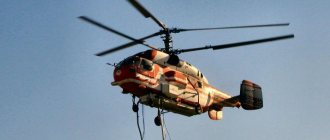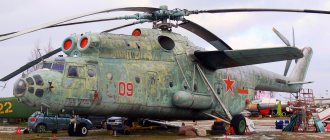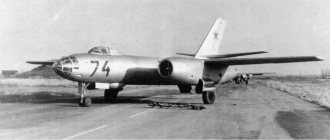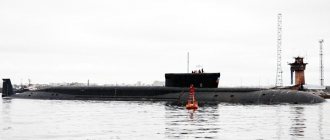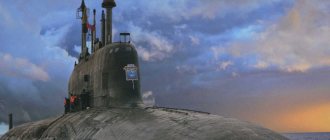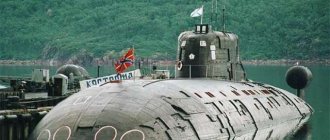Once upon a time they raced at speeds of up to 500 km/h over the surface of the water, almost touching it. Once upon a time there was a time for them to flourish. Once they were a brilliant piece of engineering and amazing military machines... But their era has passed, and the remaining iron giants live out their days, gradually crumbling into pieces. The author of the Telegram channel “Wings of War” decided to tell how the USSR made a breakthrough in the field of aviation.
What kind of cars are these?
An ekranoplan is a transport and combat vehicle capable of flying at low altitudes above the surface of water, ice or flat land. Developed during the Cold War at Rostislav Alekseev's , some ekranoplanes were more than 140 meters long and weighed more than 500 tons.
But despite this, they easily glided low above the surface of the water thanks to the screen effect. At low altitude, the air is “squeezed” between the wing and the ground, compacted and creates an air cushion, which sharply increases the lift of the wing. This phenomenon was called the ground effect, and later - the screen effect. It was discovered by aviators in the 1920s when, just before landing, the plane suddenly acquired additional lift and, ignoring controls, did not want to land.
Notes
- ↑, p. 28.
- ↑
- ↑ .
- “Lun” is the code for Project 903, and not the name of the only ekranoplan rocket created. However, for convenience and brevity, in the article the ekranoplan rocket ship will be called “Lun”.
- ↑
- ↑
- In the journal “Science and Technology” and in the books “Winged Ships of the Fatherland” and “Seaplanes and Electric Planes of Russia”, the year of testing began is 1985. In an article in the journal “Technology and Armament”, July 16, 1986 is designated as the first launching.
- Gorshkov S.G.
Sea power of the state. - M.: Military Publishing House, 1972. - .
- . TASS. Retrieved August 9, 2020.
- . www.derbent.ru. Retrieved April 6, 2020.
- Ilyin V. E., Levin M. A.
Bombers. - M.: Victoria, AST, 1996. - T. 1. - P. 68. - 272 p. — ISBN 5-89327-004-5.
Plane or ship?
Judging by the design and operating conditions, the ekranoplan is almost no different from a seaplane. The difference is in its ability to achieve stable near-aircraft cruising flight at altitudes of up to five meters. The ekranoplan also has the ability to independently stabilize in height, roll and pitch, which ensures safe flight at low altitudes above the waves. The ekranoplan flies, therefore it is an aircraft.
But marine scientists have their own opinion on this matter: the ekranoplan is the last stage in the development of the idea of lifting the hull of a high-speed vessel from the water (plane boat, hydrofoil, hovercraft, ekranoplan). Ekranoplans are more lifting and economical in contrast to conventional aircraft. The IMO (International Maritime Commission) and ICAO (International Civil Aviation Organization) have agreed that ekranoplanes are considered ships that can fly, not aircraft that can float.
Since ekranoplanes can fly at altitudes where aviation regulations apply, the IMO and ICAO divided the spheres of authority and divided ekranoplanes into three types:
- Type A - a vessel that is operated only in the area of effect of the screen effect. Such vessels are subject to maritime requirements in all operating modes.
- Type B - a vessel that can briefly leave the range of the screen effect. In this case, the distance from the surface should not exceed 150 meters. Such vessels are also subject to maritime requirements.
- Type C - a vessel certified for flights outside the ground effect area at an altitude of more than 150 meters. Such vessels are subject to maritime requirements in all operating modes, except for flights above 150 meters, where their safety is ensured only by aviation requirements, taking into account the features of ekranoplanes.
Further fate
The changes of the late 80s had a negative impact on the development program of such transport in the USSR. Work on the machines under construction stopped, and those already in use were taken out of service. But in 1989, the prospect of building an ekranoplane for civilian purposes arose - the second Lun, which was under construction, was decided to be converted into a search and rescue vessel for ships in distress.
In this regard, the rocket launchers were removed from the ekranoplan, which increased its carrying capacity and maximum speed, and the compartments freed from equipment were supposed to serve to accommodate up to 500 rescued sailors. This ekranoplan was named “Rescuer”.
But the final collapse of the country put an end to this project as well. The new government had no time for promising military projects, and the practical need for the “Rescuer” had disappeared - most of the fleet had been sold or taken out of service, and the Navy no longer had any special need for a rescue ship.
Thus, the almost completed “Spasatel” has been forgotten at the Nizhny Novgorod plant for many years, and the combat “Lun” is rusting in the dock in the city of Kaspiysk. The question of disposing of ekranoplanes and creating museum exhibits from them has been raised several times, but nothing is known about the solution to these issues.
Creator of "Caspian Monster", "Eaglet" and "Lunya"
Rostislav Alekseev is the world's main designer of ekranoplanes, whose dream of real flights was destined to come true. After defending his thesis in 1941, he worked at a tank factory. Then he was given space to work on creating combat hydrofoil boats, and, believing that Alekseev would make the boats “fly,” the Navy Shipbuilding Department allocated funds. In 1957, he introduced the hydrofoil Raketa. The well-known Soviet ships “Meteor”, “Burevestnik”, “Kometa” were also built by Rostislav Alekseev.
He began creating ekranoplans in 1962. An experimental model “Mock-up Ship”, abbreviated as KM, was created. Foreign experts have deciphered the abbreviation in their own way: Kaspian Monster (“Caspian Monster”). This colossus had a wingspan of almost 38 meters, a length of 92 meters, and a take-off weight of 544 tons. In 1966, tests of the “Caspian Monster” began at a specially created testing station on the Caspian Sea, which lasted 15 years and ended in an accident in 1980 due to a pilot error. There were no casualties. In addition, the car remained afloat for another week, but sank in the Caspian Sea without waiting for rescue.
In 1979, the world's first small ekranoplan landing ship, the Orlyonok, was accepted into the navy. It was intended for the transfer of amphibious assault forces with the ability to take off at wave heights of up to two meters. There were five units in total.
The impact ekranoplane-missile carrier "Lun" became the embodiment of all the ideas and thoughts of Rostislav Alekseev, who, unfortunately, never saw its flight. He died on February 9, 1980 due to injuries during testing of a model of a passenger ekranoplan. Two operations did not help.
The first and last attack ekranoplane-missile carrier Project 903 was built in 1986. He was a hunter of aircraft carriers, who, thanks to his enormous speed and invisibility to radar, could approach them within the distance of an accurate missile launch. It was armed with six launchers with ZM-80 Moskit anti-ship missiles. The length of this incredible miracle of technology is 73 meters and the height is 19 meters. Equipped with eight engines. Now it is decommissioned and is located in Kaspiysk.
In 2012, after information appeared that the remaining vehicles would be disposed of, news appeared in the Nizhny Novgorod media about activists who wanted to preserve the Lun ekranoplane as a museum complex. On January 25, 2020, a decision was made to transport the Lun attack ekranoplane-missile carrier to the branch of the Patriot park, which is being built in Derbent.
Performance characteristics
- Wingspan - 44.00 m;
- Length - 73.80 m;
- Height - 19.20 m;
- Wing area - 550.00 m2;
- Weight: empty aircraft - 243,000 kg,
- maximum take-off - 380,000 kg;
- 3 × 2 – PU anti-ship missiles 3M-80 “Moskit”,
Comparison with analogues
| EM type "Zamvolt" | EM type 45 | EM type 956 | "Lun" | KM | Tu-160 | Tu-95 | B-52 | |
| Appearance | ||||||||
| Maximum combat load, t | n/a | ~600 | ~1500 | 137 | 304 | 45 | 29,4 | 22,7 |
| Maximum speed, km/h | 55,6 | 53,7 | 61,9 | 500 | 500 | 2230 | 882 | 957 |
| Maximum range, km | n/a | 13 000 | 8300 | 2000 | 1500 | 13 950 | 15 000 | 16 090 |
| Total mass of cruise missiles, kg | n/a | 21 600 | 31 440 | 24 900 | n/a | 26 400 | 12 000 | 17 400 |
| Total engine thrust, kgf | 7 956 000 | 4 050 000 | 7 500 000 | 104 000 | 130 000 | 100 000 | 48 000 | 61 680 |
| Crew, people | 148 | 190 (235) | 296 (358) | 10 | n/a | 4 | 9 | 5 |
- ↑ The maximum combat load of ships requires clarification. Now this is the difference between standard and full displacement.
- The practical range in the table, in relation to ekranoplanes, is not presented very favorably, however, modern fighters, such as Su-33, Su-57, F-22, F-35, have a practical range of 1000-1500 km at the surface and 2000-4500 km on high. Thus, the maximum range of ekranoplanes is comparable to the flight range of fighters at altitude, and when flying above the surface it is even greater than that of fighters. Fighters have the ability to refuel in the air. There is no information in open sources about the possibility of refueling large ekranoplanes on the water, for example from a tanker. Probably such refueling experiments were never carried out due to the suspension of work on the projects.
- The total mass of cruise missiles is calculated based on the mass of the missiles and their number.
The future of Russian ekranoplan production
Currently, many countries are interested in developing high-speed sea routes. Mainly where there are large expanses of water. At JSC Central Clinical Hospital for SPK named after. R. E. Alekseev" work is underway to create two new-generation ekranoplans within the framework of the state program "Development of civil marine equipment."
The first passenger ekranoplane A-050-742D “Chaika-2” already has a completed preliminary design, and work is now underway on its technical component. In addition, work is underway to create a preliminary design of the A-080 ekranoplan. Both types will have two starting and two propulsion engines. They have high fuel efficiency, safety, high speed, seaworthiness, as well as high flight characteristics and all-weather use. They plan to start using the Chaika A-050 ekranoplan this year.
Also, the military modification of this vessel will be a development of the “Caspian Monster”. The developers are offering the Ministry of Defense a new generation of ekranoplanes. “Chaika-2” will be able to reach speeds of up to 480 km/h using aircraft engines on any flat surface. Experts are confident that the device has a future. The ekranoplan is unpretentious. It can land at an airfield, on a lake, or on a river. Even a one and a half meter wave will not be a hindrance for takeoff and landing. The device can move using the screen effect, and can fly like an airplane, covering a distance of up to 3000 meters. "Chaika-2" can reach unequipped land with a slope of up to five degrees. The ekranoplan can transport military personnel, weapons and ammunition, transport passengers, and be used as an alternative to air ambulances.
In March 2020, a joint order was issued by the Ministry of Industry and Trade of the Russian Federation and the Ministry of Transport of the Russian Federation “On the creation of an Interdepartmental Working Group to coordinate the development of ekranoplan construction in the Russian Federation,” which included representatives of the Ministry of Defense of the Russian Federation. Also at the meeting of this Interdepartmental Working Group, which took place on June 4 of this year, the concept “Development of ekranoplan production in the Russian Federation” was considered and adopted.
Unfortunately, after the death of Rostislav Alekseev, who made a breakthrough in the field of ekranoplan construction, much was lost, but developments are underway, and this is encouraging, because any technical innovation is a potentially useful discovery for society or the army. Other large countries, such as the USA and China, are also not sitting idly by, conducting research in the field of ekranoplan construction and even presenting models and prototypes of their machines.
The main thing now is not to waste time until Russia can take a leading position in the development of these interesting devices!
Comments on the material
Alexander Mikhalych wrote: Irreplaceable equipment, those in power are slowing down (Intentionally, no?), I accidentally saw some video about it about 10-15 years ago, I was shocked...!!! For Russia it is not replaceable, but for the military………, it is fast, economical, and most importantly, practically invisible to tracking devices (even now), and if you leave it alone?, the topic…!!! 04/01/2012 (20:17)
Ivan Almerin wrote: In my opinion, to travel in Siberia and the Far East it is necessary to build roads, and high-quality ones. And do not create equipment specifically for this. It’s not for nothing that they say: “Whatever the Russians can come up with, as long as they don’t build roads.” Ekranoplans are very important from a military point of view and ocean transportation. From the military side - a very large device, which in principle is very difficult to detect with radars like an airplane, and impossible... 04/01/2012 (20:17)
Vladimir Kalutsky wrote: That you have all fixed the roads - ekranoplanes. These are two different types of transport. You need to develop both, depending on what is profitable. Mining operations are moving further and further away from large populated areas, where workers travel on rotation. It makes sense to cost a good road 500 km for the same gold mine. The mine will run out and no one will go there and the money for road construction will be wasted... 04/10/2012 (20:51)
Vasily Krokin wrote: What does “further and further” mean? As it was originally, God knows where, it remains so now. They transport you by helicopters. 04/10/2012 (20:52)
tpkyra travorp wrote: This is our NATIONAL problem with a proven NATIONAL solution. This means that those who are not interested in the development of Siberia and the Far East are slowing down the development of this topic and the country because these narrow-minded bureaucrats need analogues from other countries, but there are simply no such countries as Russia anymore. And given the “incorruptibility” of our bureaucrats and the attentiveness of pendos, this topic has a sad future, as ... 04/10/2012 (20:53)
Raklinsky Victor wrote: We need a lot of ekranoplanes! To whom?!!! Maybe we in Siberia and the Far East are updating our aircraft fleet in accordance with needs? Are new ones being purchased to replace the medium and short-haul ones that were out of stock? No! Don't they need planes? Why are ekranoplanes needed then? In theory, the interested legal entity pays. But our theory does not work. So first the state - let it be developed... 04/10/2012 (20:54)
Vasiliev Yuri Pavlovich wrote: All ekranoplanes of the USSR were based in the city of Kaspiysk (Caspian Sea. Dagestan). The 11th ekranoplane air group was created under the subordination of the Black Sea Fleet Air Force. As part of the operational department of the Black Sea Fleet Air Force headquarters, there was the position of a senior officer - a director for ekranoplanes. This position was occupied by Lieutenant Colonel Vitaly Osin. At one time, Vitaly was the commander of a ship of one of these Caspian monsters. Already at that time, the command of the Black Sea Fleet Air Force and the Black Sea Fleet planned the participation of ekranoplanes in combat operations in the southwestern direction in the Black and Azov Seas, and possibly further. The estimated results were impressive. 01/01/2019 (15:53)
Literature
- Petrov G. F.
Seaplanes and ekranoplanes of Russia: 1910—1999. - M.: RUSAVIA, 2000. - P. 206-207. — 248 p. — 3000 copies. — ISBN 5-900078-05-1. - Apalkov V. A.
Ch. 2: Small rocket ships and boats // Ships of the USSR Navy: Directory: in 4 volumes - St. Petersburg. : Galeya-Print, 2004. - T. 2: Attack ships. - pp. 25-28. — 122 s. — ISBN 5-8172-0087-2. - Yablonsky P. P.
Winged ships of the fatherland. - M.: , 1997. - P. 44-49. — 98 s. : ill. - (Ekranoplans of the world). — ISBN 5-093-85941. - Pavel Kachur.
Part IV: Ships flying over the waves. — In: Designer of winged ships: To the 90th anniversary of R. E. Alekseev // Equipment and weapons: journal. - M., 2007. - No. 5 (May). - Yaroslav Efimenko.
Ekranoplans / Yaroslav Efimenko; Andrey Skulin // Science and technology: journal. - M., 2009. - No. 7-8.
Ekranoplan A-90 Orlyonok
The project of this ekranoplan was developed in the period from 1968 to 1970. The prototype, intended for static testing, was manufactured in the fall of 1973. After leaving the slipway, the first A-90 along the Volga was towed to the Caspian Sea. In the spring of 1974, flight tests began. In the summer of 1974, the A-90 ekranoplane performed a demonstration flight in front of high-ranking military officials. An accident occurred during this flight. The huge money allocated for the development of ekranoplanes made it possible to restore the prototype and complete flight tests by the summer of 1978. At this time, two more A-90 prototypes were under construction.
Since October 1979, the USSR Navy began testing three A-90 ekranoplanes, planning to use them as part of a unit intended for amphibious landings on enemy territory. To roll ashore, these aircraft were equipped with a ten-wheeled main landing gear and a two-wheeled front landing gear. A-90s were based at the naval base of Kaspiysk, Dagestan Autonomous Soviet Socialist Republic (now the Republic of Dagestan, Russian Federation) on the coast of the Caspian Sea. One of the A-90s was damaged in an accident in September 1992 and was later written off as a permanent loss.
The reason for the design and creation of the A-90 ekranoplanes was a practical rethinking of the experience gained during testing of the hundred-meter KM-1 ekranoplane. Initially, the A-90 was planned to be used to transport marine units of the USSR Navy. The use of the screen effect between the earth's surface and the bottom of the ekranoplan made it possible to reduce fuel consumption in comparison with an aircraft of comparable size by approximately 50%.
The extremely low flight altitude made it difficult for enemy radars to detect this aircraft. Unlike its predecessor KM-1 and the later ekranoplane "Lun", which were exclusively amphibious, the A-90 had a bow hatch, the lid of which, when opened, deviated by 92 degrees, thanks to which the equipment could be landed directly on the shore. The two jet engines in the bow were used only for launch and arrival at the beach. During the flight, a turboprop engine was used.
Instead of the originally planned 120 A-90 ekranoplanes, only three airworthy A-90s and one A-90 for static testing were built. In order to increase the number of manufactured A-90 ekranoplanes, its civilian use was proposed. Among the non-military options was a “flying ferry” for transport across the English Channel. But these plans remained unfulfilled. After the accident in September 1992 of one of the A-90s, the two remaining ekranoplans were used until October 1993. Then both A-90s were put into open-air storage at the naval base in Kaspiysk.
As in the case of KM-1, there was an experimental version of the A-90, reduced to a scale of 1:2, designated SM-2. This experimental ekranoplan was used as a stand for testing the principles of operation of the power plant, and later for training pilots.
Description of design
The ekranoplan was created according to the aircraft design of a monoplane with a trapezoidal wing in plan. Structurally, the ship includes a hull, a wing with end-shaped washers and a T-shaped tail with control rudders.
Fuselage
The fuselage is made of pressed panels, sheet and profile materials of aluminum-magnesium alloy with skin thickness from 4 to 12 millimeters. The hull has a height of 19 meters, a length of 73 meters, is divided by bulkheads into ten waterproof compartments and three decks for placing equipment and rocket crew. The wing center section is located in the middle, and a hydro-skiing device is located under the bottom. The lower part of the hull is protected by paint and varnish coatings in combination with tread protection against corrosion.
Wing and tail
The wing span is 44 meters, and the area is 550 m2. The wing is made of all-metal and has a multi-spar structure. The fuel is placed in four compartments. In addition to the tail section and the flaps, the wing is made waterproof. The flaps have a riveted multi-spar structure made of sheets and profiles, and are divided into 12 sections. The stabilizer is all-metal and has an area of 227 m2. The end is made of foam plastic with external and internal surfaces lined with fiberglass. The keel is all-metal and multi-spar with a welded skin made of pressed panels. The rudder consists of a lower and an upper section. The elevator is represented by four sections on each side.
Power point
Eight NK-87 gas turbine engines with a diameter of 1455 mm, a length of 3638 mm, and a mass of 2200 kg each, are located on a horizontal pylon in the bow of the hull.
Gas turbine engine NK-87
Weapons and equipment
In the center of the hull there are six containers for Mosquito-type anti-ship cruise missiles, with an effective firing range of 10-90 km.
Mosquito anti-ship cruise missile
Ekranoplan "Rescuer"
The second ship was also laid down as a missile carrier, but the collapse of the Soviet Union had a negative impact on the financing of the military-industrial complex. Attempts were made to complete the construction of a second ekranoplane as a search and rescue vessel, called the Rescuer. The ekranoplan had to be equipped not only with special life-saving equipment, but also have on board a hospital capable of receiving 150 victims. In a critical situation, up to 500 people could be taken on board. Work on this project was frozen in the 90s due to lack of funding when the vessel was 75% complete.
Ideal for commando raids
The ekranoplan uses an effect similar to an “air cushion” for flight, only the latter is created not by engines, but by compaction of the air flow under the wing of a low-flying vehicle. Such a flight requires two main conditions: an extremely low altitude and a very flat shielding surface of the substrate (for example, a water surface). These tight limitations are both a weakness and a strength of this type of aircraft.
There is also a hybrid of such a device with an airplane - an ekranolet. Its essence is that it can move in two modes - both airplane and ekranoplane. To switch to airplane mode, maximum engine thrust is turned on. In ekranoplane mode, the device flies with reduced fuel consumption low above the shielding surface.
After the first successful tests of the “monster,” the Soviet government instructed Alekseev Design Bureau to create an amphibious ekranoplane, and later a combat missile-carrying ekranoplane.
